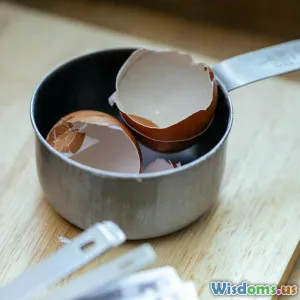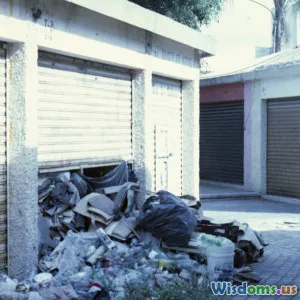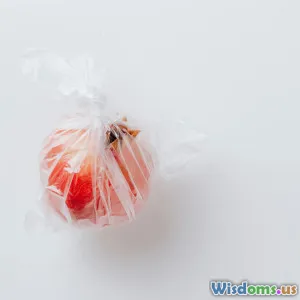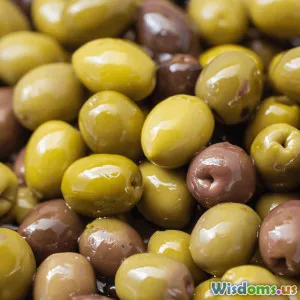
Zero Waste Cooking Tips That Save Money and the Planet
8 min read Discover practical zero waste cooking tips that cut costs, minimize food waste, and benefit the environment. (0 Reviews)
Zero Waste Cooking Tips That Save Money and the Planet
Introduction
Imagine preparing delicious meals while simultaneously slashing your grocery bills and shrinking your environmental footprint. Zero waste cooking offers exactly that — a sustainable approach to food preparation that minimizes waste, conserves resources, and saves money. With food waste accounting for roughly 30-40% of the global food supply according to the Food and Agriculture Organization (FAO), adopting zero waste habits isn't just a trend; it’s a necessary shift for a sustainable future.
This article dives deep into actionable zero waste cooking tips that not only optimize your kitchen efficiency and save dollars but also contribute positively to the planet. Join us in turning ordinary cooking into an extraordinary eco-friendly adventure.
Understanding Zero Waste Cooking
Before we delve into practical tips, it’s essential to grasp what zero waste cooking entails. Essentially, zero waste cooking focuses on utilizing every part of your food — from root to stem — to eliminate discardable waste. Beyond just scraps, it involves smarter shopping, proper storage, and creative reuse of leftovers.
By reducing food waste, you decrease methane emissions from landfills, reduce water and energy consumption linked to food production, and save your wallet from needless spending.
Smart Grocery Shopping: The Foundation of Zero Waste Cooking
1. Plan and Shop with Precision
According to a study by WRAP (Waste & Resources Action Programme), households that plan meals and shopping lists waste 30% less food. Planning meals ahead enables you to buy only what you will use.
Tip: Build weekly menus and create shopping lists focused on those ingredients. Avoid impulse buys by shopping on a full stomach.
2. Buy Loose and Bulk Items
Purchasing produce and dry goods in bulk or loose form reduces unnecessary packaging waste. Moreover, it allows purchasing exact quantities, preventing overbuying.
Example: Many cities have stores offering bulk nuts, grains, and spices you can purchase in reusable containers.
3. Support Local and Seasonal Markets
Seasonal produce tends to be fresher, lasts longer, and requires less preservation effort. Farmers' markets often allow buying products with minimal packaging, reducing plastic waste.
Efficient Food Storage: Extending Shelf Life and Freshness
Proper storage is crucial in a zero waste kitchen.
1. Know Your Produce
Understand the optimal storage conditions for different foods. For instance, keep tomatoes at room temperature to retain flavor, while leafy greens benefit from high humidity.
2. Use Airtight, Reusable Containers
Glass jars and BPA-free containers help keep food fresh longer, reducing spoilage. Reusable produce bags prevent the excessive use of plastic.
3. First-In, First-Out (FIFO) System
Organize your fridge and pantry so older items get used first. This simple method minimizes forgotten foods that often go bad.
4. Freeze Wisely
Freezing is a great way to preserve surplus food safely and extend usability.
Example: Blanch vegetables before freezing to maintain texture and nutrient content.
Creative Cooking: Using Every Bit of Food
One hallmark of zero waste cooking is innovative use of food parts typically discarded.
1. Embrace Vegetable Scraps
Instead of tossing ends, peels, and stems, save them for homemade stocks or vegetable broth. This practice reduces food waste and enhances flavor complexity in dishes.
Case in point: Chef Dan Barber uses composted food scraps and in-kitchen broths to achieve zero waste in his NYC restaurant.
2. Transform Stale Bread and Older Produce
Stale bread can be repurposed as breadcrumbs or croutons. Overripe fruits are ideal for smoothies, jams, or baked goods.
3. Make Use of Meat Bones and Fish Heads
Build rich, nourishing bone broths packed with nutrients instead of discarding them.
4. Harvest Herb Stems
Many people overlook tender herb stems like parsley or cilantro, but they carry plenty of flavor and work well in pesto or sauces.
Repurposing Leftovers: Minimize Waste, Maximize Flavor
Leftovers don’t have to be boring or repetitive; they can be a creative cooking resource.
1. Plan for Leftovers
Deliberately cook extra portions with the intent to create future meals. For example, roast extra vegetables to add to salads or wraps the next day.
2. Reinvent Leftovers
Turn yesterday’s stir-fry into a wrap or yesterday’s soup into a sauce base by blending with fresh ingredients.
3. Store Leftovers Correctly
Immediately refrigerate leftovers in portioned containers that fit your consumption habits to avoid spoilage.
Composting: Closing the Loop in Your Kitchen
Despite best efforts, some food scraps are unavoidable. Composting transforms organic waste into nutrient-rich soil, closing the sustainability cycle.
Benefits:
- Reduces landfill methane emissions
- Supports organic gardening
- Cuts down municipal waste volume
Getting Started:
Set up a kitchen compost bin for scraps like coffee grounds, eggshells, and vegetable peelings. Many cities offer curbside compost pickup or community compost programs.
Economic and Environmental Gains from Zero Waste Cooking
Zero waste cooking is economically savvy — the USDA estimates that the average American family wastes $1,500 worth of food annually. Harnessing zero waste strategies can recover a significant portion of those losses.
Environmentally, food waste represents roughly 8-10% of global greenhouse gas emissions. By slashing your food waste, you actively reduce your carbon footprint.
As famed environmentalist Jonathan Porritt says, “Sustainability is not just an environmental issue, it’s a people and economic issue.” Zero waste cooking transcends ideology, becoming a practical lifestyle choice.
Conclusion
Zero waste cooking embodies the powerful union of responsibility, creativity, and practicality. By embracing smarter shopping, meticulous storage, creative reuse, and composting, you unlock benefits from both an economic and ecological perspective.
Each kitchen scrap saved is a step toward a healthier planet and a fuller wallet. Challenge yourself today to incorporate these zero waste tips — your future self and the earth will thank you.
Remember, in the world of zero waste cooking, every bite counts.
References
- Food and Agriculture Organization (FAO), Food Loss and Food Waste Fact Sheet.
- WRAP, Household Food Waste Report.
- Jonathan Porritt, Environmental Thought Leader.
- Dan Barber, Chef and Zero Waste Advocate.
This article inspires a transformative approach to cooking — practical, impactful, and deliciously sustainable.
Rate the Post
User Reviews
Popular Posts





















